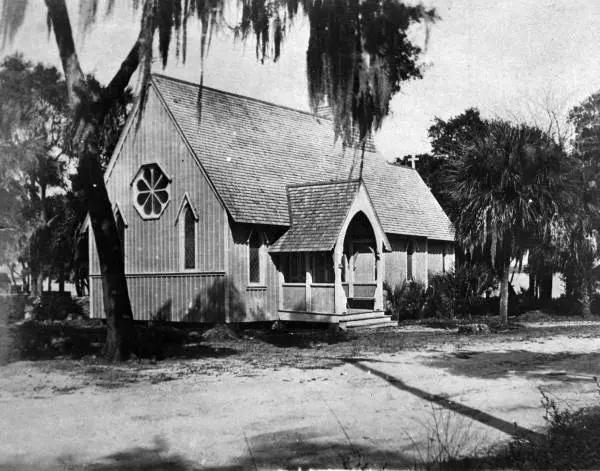Today, parking in downtown Cocoa can be at a premium when services or special events are held at St. Mark’s Episcopal Church.
When the church was first built in 1886, many in the congregation would arrive by water, mooring their boats on the banks of the Indian River. It’s just a few steps from the river’s edge to the front door of the church. Others would walk to church from homes along the river.
The first meeting of what would become St. Mark’s Episcopal Church was held on June 2, 1878. The Right Reverend John Freeman Young, Bishop of Florida, and Dr. William H. Carter of Holy Cross Church of Sanford, gathered the founding members of the church at the home of A.L. Hatch in Rockledge. Dr. Carter later moved to Tallahassee, but services continued to be held by various priests.
The church was originally called St. Michael’s, in recognition of St. Michael the Archangel.
In 1884, Mrs. Lucy Boardman, a frequent visitor to Cocoa and Melbourne from her winter residence in Sanford, donated funds to Bishop Young for the construction of Episcopal churches near the Indian River. Mrs. Sarah O. Delannoy donated the land where St. Mark’s sits today.
According to an historic marker erected by the Brevard County Historical Commission in 2010, Gabriel Gingras designed the board and batten Carpenter Gothic church. Early Cocoa residents William Booth and William Hindle designed and installed the church’s woodwork.
Dr. S.B. Carpenter, Rector of Holy Cross Church of Sanford, visited Cocoa once per month to oversee construction of the church. Although it was not quite finished, the first service was held in the new church on Christmas Eve, 1886.
The church’s tower bell, called “Michael,” was cast in New York in 1888.
In 1890, the name of the church was changed from St. Michael’s to St. Mark’s, in recognition of support provided by St. Mark’s Church in West Orange, New Jersey.
Although St. Mark’s has undergone significant additions and renovations over the years, most of the original interior woodwork and stained glass remains intact.
Many of the beautiful stained glass windows in St. Mark’s are dedicated to early founders of the church. For example, one panel is dedicated in memory of Arch Deacon William H. Gresson, who was born August 1846 and died June 1921.
Another window was created in memory of Emma J. Hardee, who was born October 6, 1847, and died May 16, 1915; and Florence H. Gingras, born May 16, 1870, and died November 6, 1913.
Sarepta E. Hartman, born May 9, 1839, and died December 9, 1924, is also remembered with a stained glass window. Another is dedicated to Cora M. Cook, born 1858, and died 1915.
When St. Mark’s was renovated in 1925, great care was taken to maintain the integrity of the original structure of the church. Stucco was added to the exterior, giving the building a Mediterranean style very popular at the time. Where additional woodwork was added to the interior, it closely matched the original.
With the addition of its first Rector, the Reverend William Loftin Hargrave, St. Mark’s was raised to “parish” status in 1938. Reverend Hargrave was later named Suffragan Bishop of the Diocese of South Florida and Bishop of Southwest Florida.
In February 1942, the Emma Cecilia Thursby Memorial Fellowship Hall was completed, providing space for community gatherings. Thursby was a popular opera singer in America and Europe in the late 1800s and a professor of music at the Institute of Musical Art, now the Julliard School, in the early 1900s. Thursby and her sister wintered in Cocoa.
St. Mark’s Parish Day School, known today as St. Mark’s Episcopal Academy, was established in 1956. Since then, education has been a primary focus of the church.
The most recent renovations to St. Mark’s Episcopal Church were in 1994, when the worship area was expanded to its present capacity, and in 2012, when pews modeled after the originals were installed.
While fewer people walk to church or moor their sailboats nearby as they did in 1886, the full parking spaces around St. Mark’s each week indicate that the church is as vital a part of the Cocoa community as ever.

